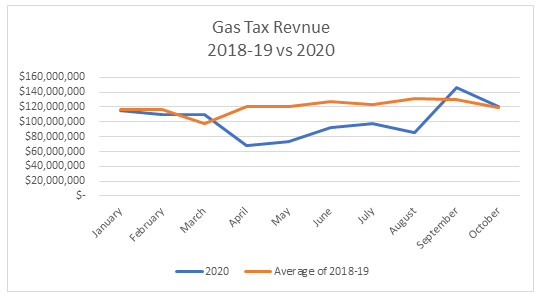How much did the COVID-related lockdowns reduce Washington’s CO2 emissions from cars and freight? Probably not enough for the state to meet its CO2-emissions reduction target for 2020. That answer should cause legislators to significantly reassess our state’s climate policy.
Since the lockdowns began in March, gasoline sales are about 16 percent lower when compared to the average of 2018 and 2019. Diesel fuel, which is more associated with freight transport, is down only 7.7 percent, by way of comparison. Interestingly, gas sales in September and October for both gasoline and diesel were back to normal levels.
 Between March and October, the state received about $190 million less than it did on average in 2018 and 2019, amounting to about 384 million fewer gallons of gas and about 3.4 million metric tons of CO2. The difference for diesel is much smaller, with the state receiving $22.7 million less in taxes, representing about 46 million gallons and about 467,000 metric tons of CO2.
Between March and October, the state received about $190 million less than it did on average in 2018 and 2019, amounting to about 384 million fewer gallons of gas and about 3.4 million metric tons of CO2. The difference for diesel is much smaller, with the state receiving $22.7 million less in taxes, representing about 46 million gallons and about 467,000 metric tons of CO2.
Gas and diesel don’t account for all of Washington’s transportation-related CO2 emissions. Of the 44.5 MMT of CO2 from transportation in 2018, gas and diesel account for 27.8 MMT, about 62 percent of transportation-related emissions.
All of that adds up to a reduction of about 3.9 MMT of CO2 during the lockdowns from personal vehicles and on-road freight transportation. To get from the state’s 2018 CO2 level of 98.9 MMT CO2 down to the 2020 target of 90 MMT, there will have to be an additional 5 MMT of CO2 reduction found somewhere. This seems unlikely since there isn’t much CO2 reduction available from electricity in Washington and while there may be a reduction in CO2 from commercial industries, there will probably be an increase in residential energy.
And, as the rebound in demand in September and October demonstrate, the reductions are probably transitory and will return to normal levels in 2021.
Even if the state does somehow meet the 2020 goal, it will be very close and will demonstrate two things.
First, it will show how, despite the claims of climate “leadership” from politicians at the state, county, and city level, we are nowhere close to meeting the CO2 targets adopted by the legislature. Emissions increased again in 2018 and seem likely to be at a similar level in 2019.
Second, the numbers make it clear that the state’s CO2 targets are not based on reality, science, or sound economics. If even something as serious as the COVID lockdown only reduces gas and diesel CO2 emissions by 14 percent, reducing total emissions by an additional 45 percent to meet the 2030 target seems fanciful.
One additional note is important. Purportedly, the state’s CO2-reduction targets are set to keep temperature increase to 1.5 Celsius compared to pre-industrial levels. It is claimed these are based in science. This is simply false. There is nothing special about 1.5 degrees, or 2 degrees – the target set in the Paris Climate Accord – or 3 degrees as far as science is concerned. The question is one of economic, ecological, and value tradeoffs. If we could meet the 1.5-degree target for a cost of $1, there would be no debate about whether we should do it. I would Venmo the money today. Economics, not science, is the crux of the issue despite the claims of politicians who pretend otherwise.
Tradeoffs must be considered. If it costs $100 trillion to meet the CO2-reduction target, but only $10 trillion to deal with the costs of higher temperatures, the world would be better off spending the $10 trillion (heck, throw in an additional $5 trillion), rather than impoverishing everyone and creating hunger, misery and death. Hunger is an existential crisis for someone whose money for food went to subsidize a Tesla owner.
Key to any successful climate strategy is to drive down the cost of reducing CO2 emissions. Only technology can do that. And, rather than rely on speculative but expensive regulatory approaches like a low-carbon fuel standard or subsidies for rooftop solar, legislators should focus on the lowest-cost efforts that yield the most environmental benefit for every dollar spent.
The unwillingness to base our climate policy in reality – to set rational targets and focus on effective strategies to reduce CO2 emissions – means Washington will continue to miss all of our targets while imposing high costs on the people of the state.





